Rottweilers are one of the most popular dog breeds for a reason, but did you know there are different types? Rottweilers have two main classifications, German or American. But what’s the main difference between the German Vs American Rottweiler? Their origin! German Rottweilers are bred in Germany, and the American Rottweiler is bred in the United States. The German Rottweilers are sometimes larger than their American counterparts, but there is much more to each of these Rotties than meets the eye!
The Main Differences Between German Vs American Rottweilers
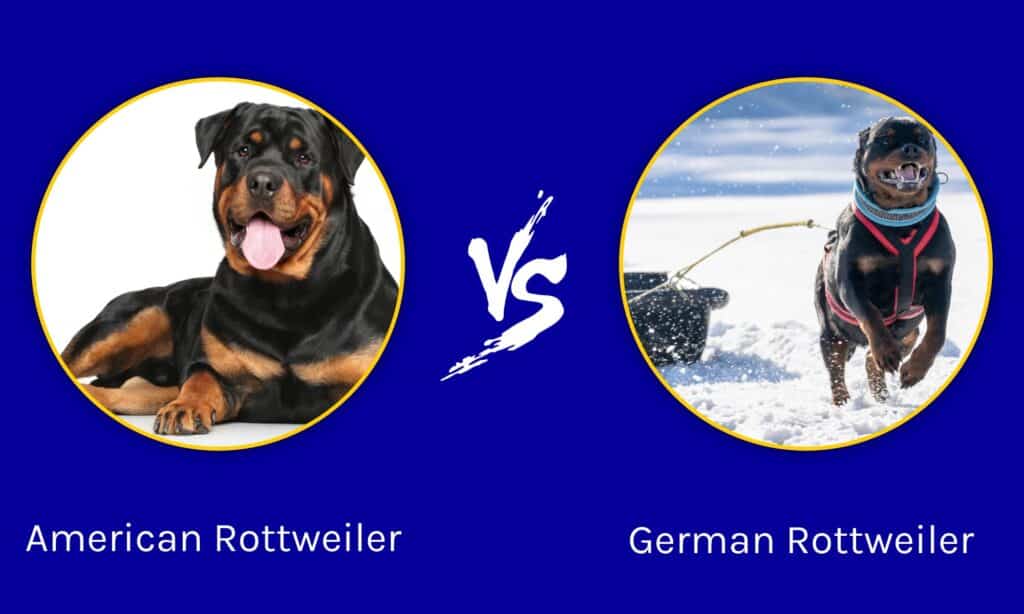
As noted above, the primary difference between the German and American Rottweiler is where they’re bred. However, there are some notable differences between the two. German Rottweilers tend to be stockier and more muscled while American Rottweilers tend to be sleeker. In addition, there may be slight differences in their temperaments. Let’s dive into more details on the differences between an American Rottweiler and a German Rottweiler!
German Vs American Rottweiler: Physical Characteristics
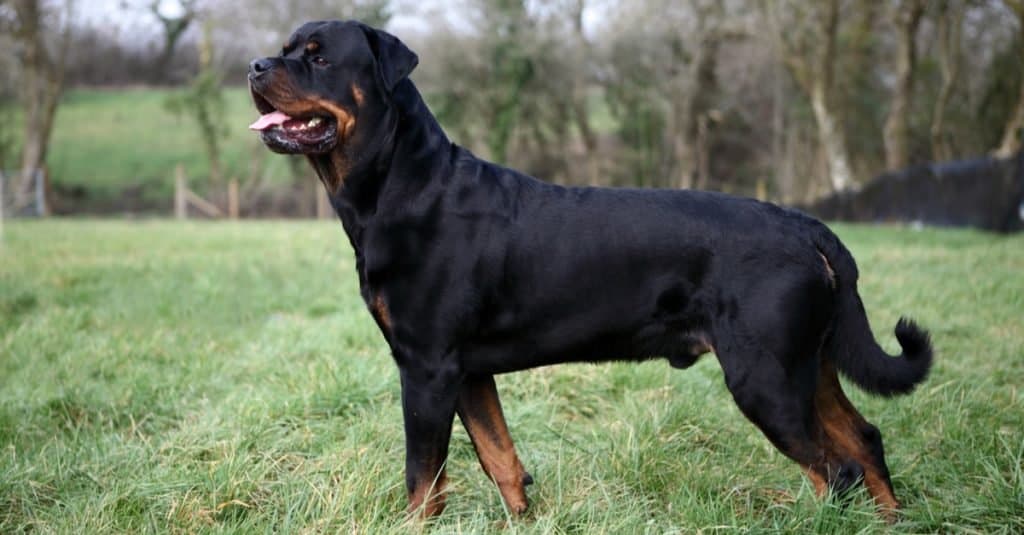
While German Rottweilers are often a bit larger than American Rottweilers, the main difference between the two is their origin! German Rottweilers are bred in Germany, and American Rotties are bred in the U.S. But there are physical differences, such as the shorter nose and thicker neck of the German!
©Miroslav Cik/Shutterstock.com
While German Rottweilers tend to be a bit larger, both breeds are equal in terms of average size overall. Rottweilers are between 80-110 pounds on average and between 24-27 inches high. Both breeds have standard black and tan coats and markings distinctive to the Rottweiler. Rottweilers are also one of the strongest dog breeds and need early training to help harness all that power! However, there are other key physical differences between the two that set them apart!
Physical Characteristics To Identify A German Rottweiler
Many German Rottweilers are often the same average height and weight as American Rottweilers but tend to carry it differently. German Rotties appear stockier and more muscled, with a broader body shape. German Rotties must be short-haired and require minimal grooming.
These Rottweilers have broader noses, almond-shaped eyes, triangular ears, and thicker necks. The Allgemeiner Deutscher Rottweiler-Klub (ADRK) has very strict standards for the German Rottweiler. Acceptable coat colors are black and mahogany, black and tan, or black and brown. Tail docking is highly discouraged and is considered grounds for the breed to fail to receive ADRK certification.
Physical Characteristics To Identify An American Rottweiler
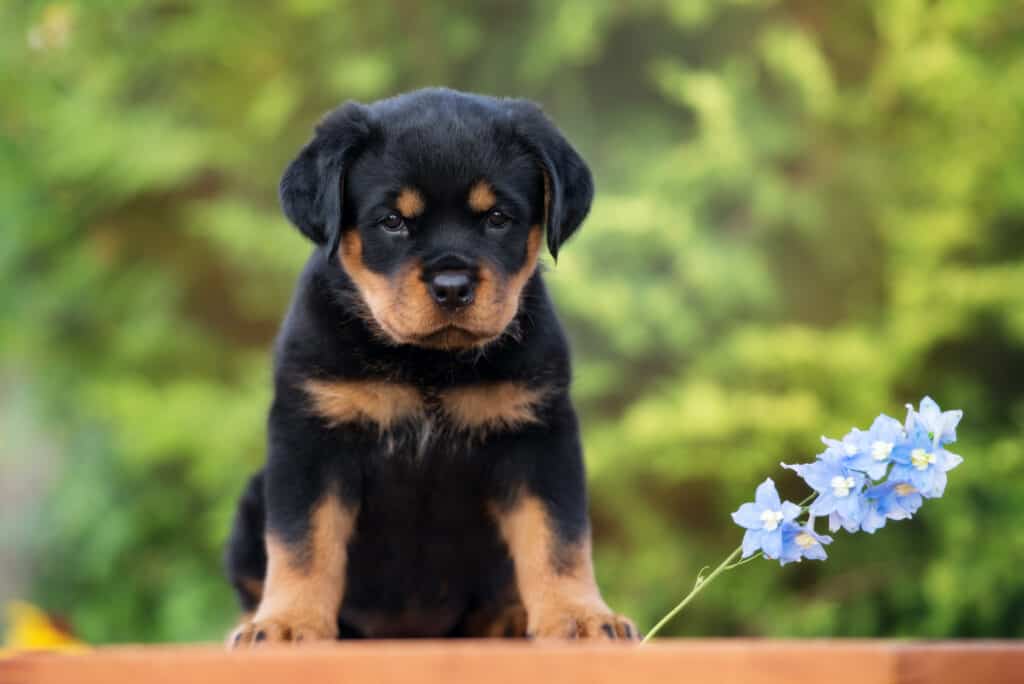
Rottweiler puppies should be walked 2-3 times a day, for 20 minutes each time.
©otsphoto/Shutterstock.com
The American Rottweiler is sleek, leanly muscled, and less broad than the German Rottie. They have a more athletic form and a smaller nose. Tail docking for the American is common and was considered a breed standard by the American Kennel Club (AKC), though docking is no longer required. However, the AKC is less strict about coat colors and adds red and blue variations to the breed standard. The American Rottweiler can be long-haired as well, though this is not a breed standard.
American Rottweilers have medium-length heads that are broader between the ears. The American also has the standard triangular-shaped ears and almond eyes common for Rottweiler breeds. The American Rottweiler has an arched neck of medium length, a broad chest, and a well-sprung oval ribcage noticeably narrower than the German Rottweiler.
German Vs American Rottweilers: Temperament And Behavior

In addition to physical differences, the German Rottweiler has much stricter regulations for behavior. While both are loyal, calm, and intelligent, the German Rottweiler is specifically bred to be the gold standard for what makes the perfect companion.
Both the German and American Rottweiler are known for their calm, easygoing demeanor and working dog loyalty. They are highly intelligent, in fact, Rottweilers are one of the Top Ten Smartest Dog Breeds! Rottweilers can learn a new command in five repetitions or less and are one of the most popular dog breeds.
However, there are some differences between the German and American Rottweiler temperaments. It’s important to know the breed standards for both types before deciding on which Rottie is right for you. Additionally, the standards for temperament and behavior are quite different for dogs that compete in shows!
Temperament and Behavior Of a German Rottweiler
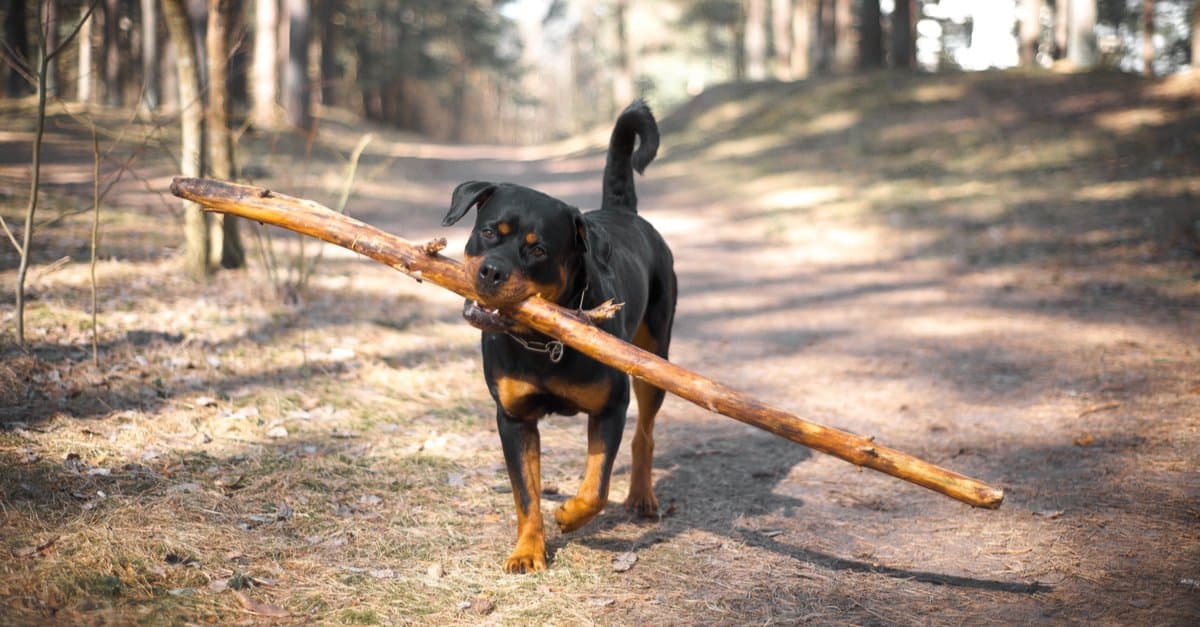
Rottweilers have a fiercely protective nature.
©Mariya Kuzema/Shutterstock.com
The German Rottweiler was specifically and carefully bred to be the perfect companion dog. As such, the standard temperament and behavior necessary for a dog to be ADRK-Certified is a high bar indeed! German Rottweiler breeders are held to extremely high standards, and breeding pairs must be approved by the ADRK.
German Rottweilers are the gold standard for their breed. They are calm, steady, and dependable dogs that are the pinnacle of loyalty and protection. Additionally, the German Rottie is calm, easygoing, playful, and great with children. When raised alongside other pets, they form deep bonds with other animals. They respond well to training and have an astounding level of intelligence, able to learn a variety of commands quickly. However, like all large dogs, training should begin early!
Temperament And Behavior Of an American Rottweiler
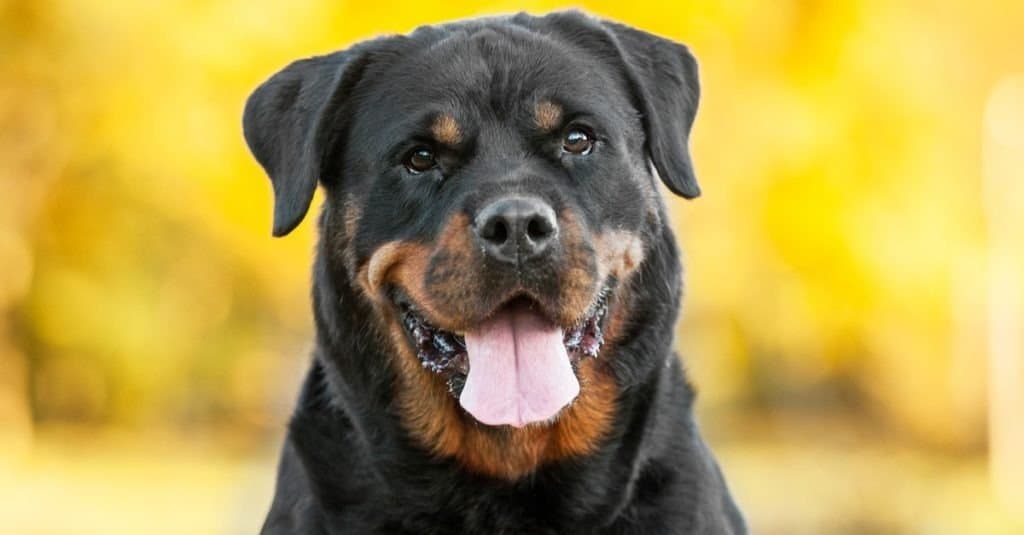
Rottweilers love to lean their bodies against their people.
©Rita_Kochmarjova/Shutterstock.com
American Rottweilers are no slouch when it comes to personality either! The American Rottweiler shares the deep loyalty, high intelligence, and easy trainability of the German. They are every bit as able to be a fantastic family dog and are good with kids as their German relatives.
However, American Rotties can be reserved around strange people and animals, and often display aggression with dogs of the same sex. Interactions with any strange person or animal should be monitored. The American Rottweiler responds well to training and is eager to please their owner but is often more stubborn than their German counterpart!
German Or American: Which Rottie Is Right For You?

Rottweilers can be extremely gentle and loving.
©Rita_Kochmarjova/Shutterstock.com
Both the German and American Rottweiler exemplifies the best qualities of a desirable family dog. Deciding on which is right for you can be difficult! However, there are a few things to look out for when making the choice.
German Rottweilers and the ADRK’s strict guidelines for the breed are a good choice for someone who wants a steady, reliable dog. German Rotties are specifically bred to have fewer health issues common with large dogs, such as hip or elbow dysplasia. The sale of puppies with genetic health issues is simply not allowed by the ADRK. However, this will mean that a German Rottie will be significantly more expensive.
The American Rottweiler is far less restricted by the AKC. While this means that the likelihood of genetic health issues is higher, purchasing an American Rottie is much more cost-effective. For families looking for a more energetic companion with a leaner build, the American Rottweiler may be right for you!
What’s the Difference Between a German Rottweiler and a Roman Rottweiler?
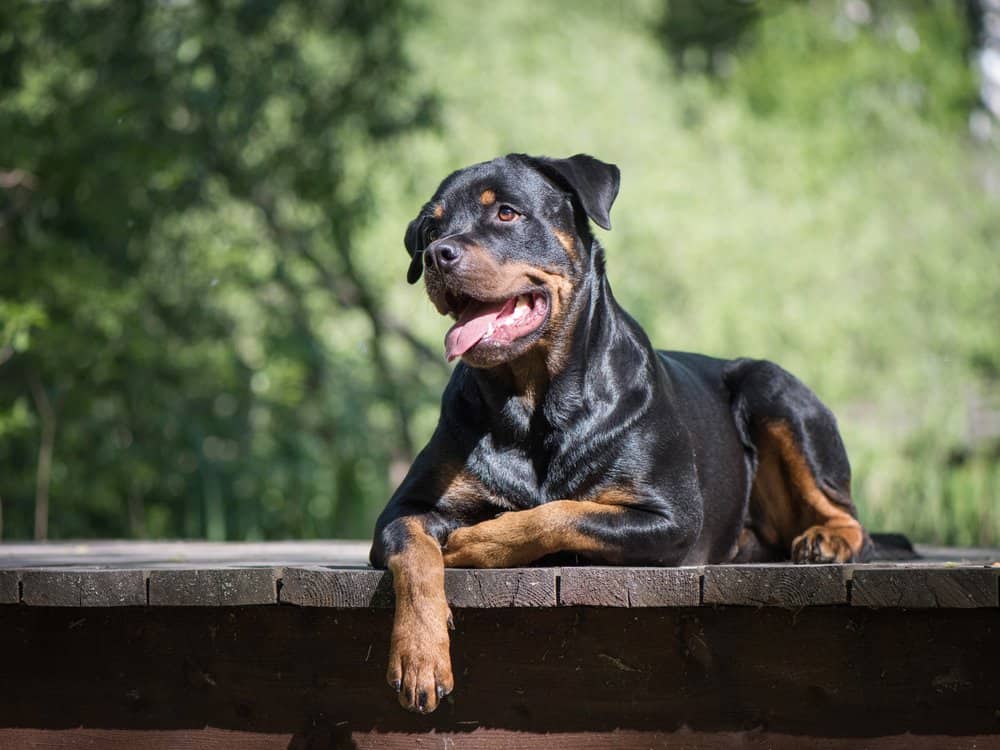
The Roman Rottweiler received its name due to its history of being used by ancient Romans for herding.
©EKATERINA SOLODILOVA/Shutterstock.com
The Roman Rottweiler differs slightly from the German Rottweiler but is not considered its own breed. This type of Rottweiler, which often is a combination of a Mastiff and a Rottweiler, was named as such because it was used to herd animals by the ancient Romans. Both Roman and German Rottweilers come from Germany.
In terms of size, German Rottweilers average 27 inches in height for males and 25 inches for females, while Roman ones measure from 24-30 inches for males and 22-25 inches tall for females. Roman Rottweilers weigh up to 95 pounds, while German ones weigh from 85-130 pounds. In both types, the females average lighter than the males.
Roman Rottweilers have short, straight, and coarse double coats with undercoat present on the neck and lower torso; the outer coat is medium length. A topcoat and an undercoat are present in German Rottweilers, but the undercoat is fully hidden beneath a medium-length, rough topcoat.
Breed standards for the German Rottweiler dictate that their colorings are Black/Mahogany, Black/Rust, and Black/Tan. For Roman Rottweilers, there are more variety of colorings like red, blue, and black options.
Both breeds share temperaments being protective, sociable, calm, intelligent, and watchful. Roman Rottweilers are great working dogs and have often been utilized as police, military, or customs dogs.
The photo featured at the top of this post is © Mariya Kuzema/Shutterstock.com
Ready to discover the top 10 cutest dog breeds in the entire world?
How about the fastest dogs, the largest dogs and those that are -- quite frankly -- just the kindest dogs on the planet? Each day, AZ Animals sends out lists just like this to our thousands of email subscribers. And the best part? It's FREE. Join today by entering your email below.
Thank you for reading! Have some feedback for us? Contact the AZ Animals editorial team.






